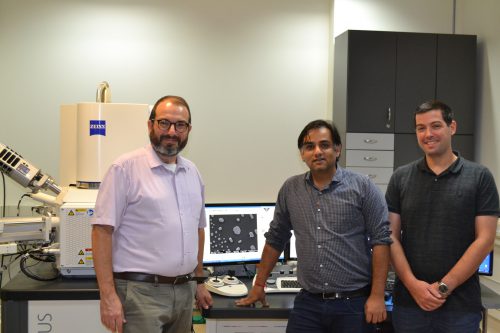As part of the study, the mechanical properties of nanometric nickel particles were investigated under pressure. The maximum strength of these particles, 34 gigapascals, is 3 times higher than the strength of microscopic iron fibers, which are the metallic structures with the highest maximum strength ever measured. This achievement is based on unprecedented control over the configuration of the particle walls and coatings in a shell made of nickel oxide

Researchers from the Technion and George Mason University have set a new benchmark for the strength of metallic materials. As part of the study, the mechanical properties of nanometric nickel particles were investigated under pressure. The maximum strength of these particles, 34 gigapascals, is 3 times higher than the strength of microscopic iron fibers, which are the metallic structures with the highest maximum strength ever measured. This achievement is based on unprecedented control over the configuration of the particle walls and coatings in a shell made of nickel oxide.
The research published in the journal Nature Communication paves the way for studying the behavior of metallic materials under super-high uniaxial stresses. So say the researchers who led it, Prof. Eugene Ravkin from the Faculty of Materials Science and Engineering at the Technion and Prof. Yuri Mishin from George Mason University. "The strength of a material is an important property that determines the range of its possible applications," explains Prof. Ravkin. "At the atomic level, the strength is determined by the type of chemical bonds between the atoms. For example, a diamond is a very strong material because of the strong covalent bonds between the carbon atoms that make it up. Aluminum, on the other hand, is very weak because the bond between its atoms is weak."
Strong materials are of course a major goal in science and technology, so many research groups are working on creating strong materials. Materials have a theoretical strength limit - similar to the speed of light which is the upper limit for the speed of matter and energy. According to Prof. Ravkin, "We strive to approach the upper limit of the material's strength, but in practice we were very far from it due to defects in the crystalline structure. That is why we have been researching for many years the possibility of improving the quality of the crystal and thereby increasing its strength."

In 2011, Prof. Rabkin and his partners at the Technion, Stanford and Princeton, Prof. Dan Mordechai, Prof. Bill Nix and David Serolowitz succeeded in producing nanometric gold particles with the highest theoretical strength. This is thanks to the special structure of the particles they created. However, this strength is not high compared to other metals, and therefore the researchers tried to apply the new method to nickel as well.
In the current study, which was conducted with a combination of experimental and computational tools, nickel particles were produced that exhibited a much higher resistance than the gold particles. According to Prof. Ravkin, "We were especially surprised because our particles showed high resistance even in relation to previous computational results of the theoretical strength of the nickel particles."
To understand the findings, the researchers performed a careful characterization of the nickel particles and verified their hypothesis: particles with blunt corners withstand higher pressures than those with sharp corners. Following the discovery, they developed a unique algorithm that produces diverse nanometer particles in terms of the nature of their wigs. Indeed, the more rounded particles withstood much higher pressures, while the sharp-edged particles collapsed at a relatively early stage. As mentioned, the research paves the way for the understanding and creation of particles stronger than different metals.
